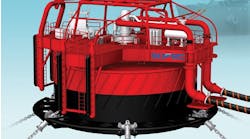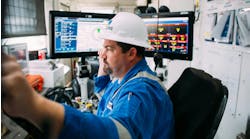The Norwegian KAPOF group is an organization of oil and gas research and development firms, laboratories, institutions, and agencies that have utilized government and industry funds to create technologies that improve industry functions and meet needs. The following is a brief view of the technologies developed by KAPOF:
Sulfur extraction
The AVSUR sulfur extraction plant developed by ABB Mil utilizes a cyclic regenerative process that simultaneously removes H2S and water from produced gas. The off-gas containing H2S is fed to an incinerator and the resulting SO2 is absorbed in sea water. The AVSUR plant can be installed as an add-on to an existing gas drying plant or optimally designed as a complete facility.
Circle 1 on Reader Service Card
Subsea welding
The SAG-FW (Shield Active Gas Forge Welding) technology developed by AMR Engineering welds pipe cross-sections and bolt sections in one operation. The method is suited for long series of similar welds (e.g. welding of pipeline spools). By utilizing the SAG-FW welding method, the cross section of pipe can be welded in approximately four minutes, independent of pipe diameter and wall thickness. Carbon steel, duplex acid-resistant steel and 13% Cr stainless steel can be welded by the SAG-FW method.
Circle 2 on Reader Service Card
Fiber optic well monitoring
A fiber optic well monitoring system developed by Alcatel Kabel Norge monitors downhole pressure and temperature, and transfers the sensor signals to topside equipment via fiber-optic cables. This technology provides downhole sensors which are reliable under high pressure and high temperatures, and a signal transfer system with stable operating characteristics. Sensors contain simple swing circuits based on passive electronics, and registered values are transmitted as a frequency signal by optical fibers encased in a continuous steel pipe.Circle 3 on Reader Service CardTracer injection
The Xpel downhole injection tool developed by Altinex provides for safe, reliable tracer injection into water or gas wells. The tool allows complete surface control of the tracer injection process, exact placement in zone of choice, precise control of tracer volume and concentration, and downhole cleaning of tracer chamber, injection canals and tool body. Xpel provides improved tracer tests for reservoir static and dynamic mapping, reservoir assessment and optimization of production strategy, and reduced consumption of tracer elements.Circle 4 on Reader Service CardFire and gas detection
The self-verifying gas detection system developed by Autronica facilitates testing of fire and gas detectors by verifying the condition of all detectors from one panel. This eliminates the need to trace all detectors and perform tests at each detector location. The system comprises a central cabinet and a system for communication with the measuring chamber of each detector. Verification by the centralized system has the same level of functionality as manual testing of detectors.
Circle 5 on Reader Service Card
Oil/water treatment
Betex has developed the FilSep membrane treatment unit for produced water/oil emulsions to achieve low ppm (10-15) in clean water discharge. The treatment unit is designed for continuous operation to meet offshore specifications. FilSep utilizes a cross-flow membrane technology that is ideal for handling difficult oily water emulsion as well as separating dissolved materials and heavy metals. Concentrated oil can be skimmed off or returned to the feed tank, and clean water can be discharged to sea or reinjected.
Circle 6 on Reader Service Card
Epoxy-inflated packer
Developed by Brdashnnteknologiutvikling (BTU), a new epoxy-inflated external casing packer provides reliable zonal isolation in open holes. Since many failures in conventional packers and associated leakage between zones is due to the inflating medium (fluid or cement), BTU researched and field-tested epoxy as an inflating medium with excellent reliability results. Economic benefits include improved production rate and reduced installation and workover costs.
Circle 7 on Reader Service Card
Internal cathodic protection
CorrOcean has developed its resistor-controlled cathodic protection (RCP) technology to better control internal corrosion of alloyed stainless steels in chlorinated sea water piping systems. A new design concept which improves on the well-known cathodic protection method, The RCP method utilizes a resistor in series with the sacrificial anode to control both the potential on the stainless steel and the anode current output. Due to very low current requirements in the relevant potential range, a single anode can protect a large area at a very low anode consumption rate.
Circle 8 on Reader Service Card
Fieldbus system
Fieldbus International has developed the ISIbus system to offer simplified and reliable digital communication between instruments and actuators, and the computers monitoring and controlling their processes. The system eliminates separate instrument cables and marshaling cabinets, which result in substantial reduction of topside weight and installation costs. Functionality advantages include spark-free inductive coupling, capability for power distribution via the same pair of wires used for signaling, and high data rate for large network configurations. ISIbus is compatible with the IEC 1158-2 Fieldbus standard.
Circle 9 on Reader Service Card
Multiphase flow meter
Designed for a wide range of flow regimes, the MPFM 1900 multiphase flow meter developed by Fluenta is a non-intrusive in-line metering station. The system makes measurements based on the electrical characteristics of the flow. The MPFM 1900 measures water cuts up to 100% and gas fractions up to 95%, and includes a Venturi-meter to cover single phase and very homogenous flows. The system eliminates costs associated with separators, valves and separate metering of flow phases.
Circle 10 on Reader Service Card
Centrifugal separator
The centrifugal multiphase separator developed by Framo continuously separates oil, water, gas and sediments to meet oil & gas product specifications and statutory requirements on waste water contamination. The system utilizes the rotating disk method with a special design of the separator inlet and disk chamber. This allows for simultaneous separation previously unavailable with rotating disk-type separators. The centrifugal separator offers several advantages over tank separators, including lighter weight, smaller size and improved efficiency on floating platforms.
Circle 11 on Reader Service Card
Mapping/modeling system
Geomatic is developing IRAP2, an geological mapping system for petroleum and hydrographic applications. The system utilizes advanced technologies for user interface, visualization, griding, modeling and map production. IRAP2's mapping capabilities are fully integrated with 3D geological modeling tools, and allow for user editing of the final map. Object-oriented user interfaces have been proven successful in a reservoir modeling system previously developed by Geomatic.
Circle 12 on Reader Service Card
Drilling control unit
Hitec's multi-purpose integrated drilling system unit comprises a computerized control unit with interface to several systems operated by the driller, including BHA control, drawwork, iron roughneck, mud pumps and pipe-handling machines. Operations such as installation of drill pipes, hoisting and lowering of drillstring, and presetting of drilling depth are handled by the control unit, which is built into an ergonomically designed chair/console for the drill operator.
Circle 13 on Reader Service Card
Personnel tracking
The MIRIS personnel tracking system developed by Miros keeps an exact record of the location of all staff at all times. The system utilizes passive reflectors carried by personnel which respond to signals transmitted from a radar and communication system. Therefore, detection does not require personnel being tracked to activate a signal trigger. Typical applications include personnel monitoring between platforms, embarking and leaving lifeboats, and movements in and out of hazardous areas.
Circle 14 on Reader Service Card
Multiphase meter
The MFI Multiphase Meter developed by Multi-Fluid International provides high accuracy for water-in-oil measurements. Utilizing microwave measurement technology, the meter eliminates the need for costly installation of separator, test pipelines and metering equipment. The MFI covers a large operation envelope including 0-100% water cuts, and represents the state of the art in multiphase measurement for topside and subsea installations.Circle 15 on Reader Service CardWater separator
Norwet has developed a water separator which utilizes a membrane process that simultaneously removes water, dissolved hydrocarbons and heavy metals from producing wells. The membrane separation method eliminates costly, bulky and heavy equipment required by other water separation techniques. Separator removal efficiency is 96% for total hydrocarbon content and metal particles.
Circle 16 on Reader Service Card
Subsea acoustic camera
The EchoScope 3D acoustic camera developed by Omnitech generates a three-dimensional acoustic image based on one ultrasonic shot. This technology is ideal for subsea inspection work which cannot be accomplished by video cameras (limited underwater visibility) or 2D sonar imaging. The camera is operated by an ROV and is connected to an electric power pod and connector for transmittal of electrical/optical signals. Imaging distanceranges from 0.5-20 meters. Digital images are stored on disk for later retrieval and analysis.Circle 17 on Reader Service CardMembrane gas dehydration
Permea Maritime Production has developed a membrane dehydration system which counteracts the limitations of heavy, space-consuming equipment required by the adsorption process conventionally used for gas dehydration. The system is well suited for remote operation, and requires minimal maintenance. The membrane dehydration system can be used on unmanned platforms, to expand dehydration capacity at existing plants, to develop marginal onshore fields, and to dehydrate flared gas.
Circle 18 on Reader Service Card
Water monitoring
Petrotech's multi-ion water management system provides continuous, automated monitoring of formation and injection water, well clean-up, early detection of water break-through in reservoirs, and general laboratory water analysis. The system provides complete information on water composition from a single sample by utilizing ion chromatography, high-performance liquid chromatography, and multivariate analysis of registered data. Key features include detection of need for well stimulation to avoid scaling, wash-out of scale deposits, and clean-up of salt used for open hole sealing.
Circle 19 on Reader Service Card
Basin modeling
ProCom's basin modeling toolbox (BMT) is a decision support software system for use by oil company explorationists. BMT provides an integrated set of tools to simulate sediment compaction, sequence stratigraphy, structural restoration of normal faults incorporated in the geohistory reconstruction, 2D subsidence and heat flow calculations, and thermal conductivity prediction. BMT runs under X-Windows and operates under the Motif window manager.
Circle 20 on Reader Service Card
Subsea inspection tool
Robit has developed a modular ROV-operated inspection tool providing simplified and precise probe manipulation. The tool is easy to deploy from a wide range of work-class ROVs. A powerful subsea computer handles probe control, inspection data storage/analysis, and communication. Task capabilities include ultrasonic corrosion mapping, eddy current detector positioning, erosion mapping, sand detection, weld inspection and grinding.
Circle 21 on Reader Service Card
Planning/analysis tool
Developed by Scandpower, DECISION is a unique tool for planning and analysis of simulation studies. It facilitates decision making prior to computer-intensive simulation and sensitivity studies. Applications include reservoir development and management, and multiphase flows in pipelines. Features include operations on dependent and independent variables, regression analyses, automatic selection of model for surrogate simulator, and Monte Carlo simulation of uncertainty. Typically, DECISION reduces the number of required computer runs by 30-40%.
Circle 22 on Reader Service Card
Seabed sediment sampling
Developed by Selantic Subsea Technology, the hydrostatic sediment corer extracts sediment core samples from the seabed for analysis prior to installation of pipelines, platforms, or seabed equipment. The corer is penetrated into the seabed by hydrostatic pressure, which allows for retrieval of longer core samples (and more information). The hydrostatic sediment corer is fitted with handling and instrumentation modules to comprise a complete marine sediment coring system.
Circle 23 on Reader Service Card
Subsea battery
Developed by Simrad Norge, the SWB 501 is an electrical power supply offering a 3-5 year service life. Ideal for low-power, long-term subsea applications, the battery uses sea water as electrolyte, a copper structure as cathode, and a magnesium electrode. When compared to lithium batteries, the SWB 501 is less expensive and easier to renew. Replacement of the expended magnesium bolt can be accomplished by an ROV, which drops a new bolt in a conical guide funnel in the battery.
Circle 24 on Reader Service Card
Mud-gas separator
Developed to meet the demands of deep, high-pressure gas wells, Smedvig Technology's mud-gas separator is a cascade-type separator. A large flow area dramatically improves separator efficiency as compared to conventional equipment. It features large surface baffle trays for efficient separation, large gas and liquid outlets, and replaceable wear parts in the upper baffle tray and inlet nozzle. The vessel is constructed of lightweight composite materials, and it meets all recognized pressure vessel codes.Circle 25 on Reader Service CardJet-fire propagation
prevention
Currently in development by Trelleborg Viking, Viking jetfire stop is a new material designed to prevent propagation of jetfires on offshore platforms or in processing plants. In response to new requirements enacted by British and Norwegian authorities in May 1993, the material is designed for use on a passive protection system which can stop the propagation of a jet-fire with a heat flux of 300 kw/m2.
Circle 26 on Reader Service Card
Cement resins
WeCem has developed superior thermosetting resins for oil well cementing applications. Specifically, these resins have been developed for zonal isolation against water production, squeeze cementing, control of severe circulation loss, side track wells, and isolation plugs. These resins have resulted in cost-effective cementing systems which are insensitive to contamination by water, oil, or oil well chemicals.
Circle 27 on Reader Service Card
Copyright 1995 Offshore. All Rights Reserved.


